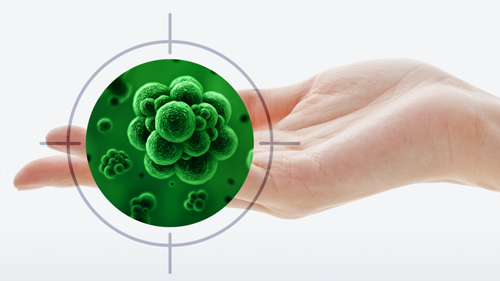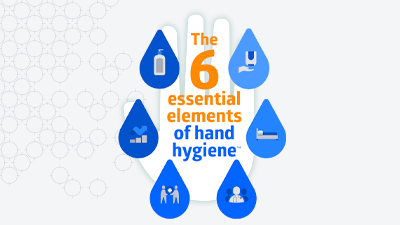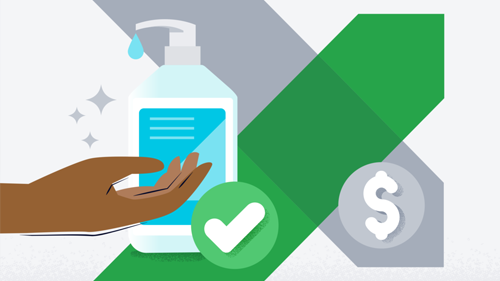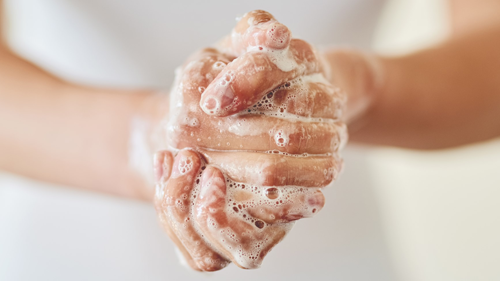How to educate patients, residents and visitors on hand hygiene
It’s up to all of us to improve infection control in healthcare facilities.
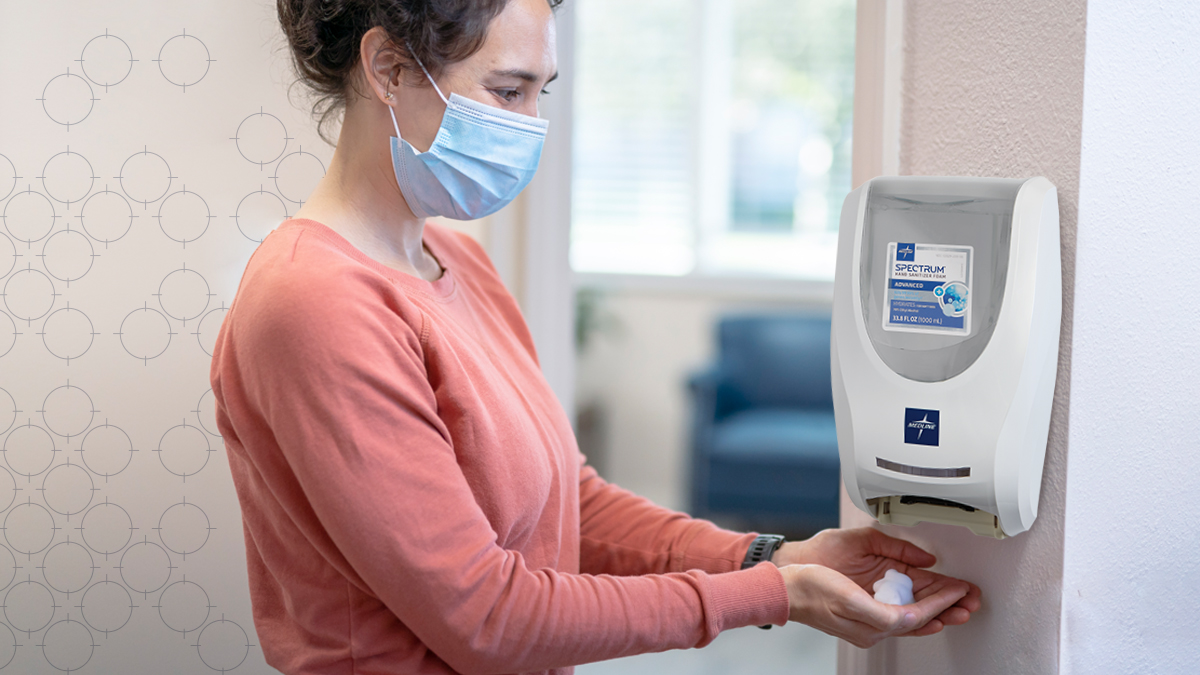
You already know that consistent hand hygiene is key to implementing an effective infection prevention and control strategy. And you work hard to promote compliance among healthcare workers. While everyone plays a role in preventing healthcare-associated infections (HAIs), some roles get less attention—specifically, patients, residents and visitors in healthcare facilities.¹
More attention is part of the answer:
- A study found that improving patients’ hand-hygiene practice reduced rates of infection with vancomycin-resistant enterococci and MRSA¹
- In a long-term care facility, residents were aware of the importance of hand hygiene, but barriers, such as inaccessible products or difficult to use products, limited compliance²
- Research studies have found that visitors’ hands become a reservoir and means of transmission if not adequately cleansed³
What does it take to connect with these groups and improve hand hygiene rates? Play it by EAR: education, access and reminders.
Empower patients and residents to help themselves
Engage people in hand hygiene adherence by educating them on why it’s important, providing access to appropriate hand hygiene products and teaching patients and residents when and how to clean their hands effectively.
Less than 35% of patients
washed their hands after using the toilet, according to a study.¹
“Patients should be educated when they’re admitted,” says Paul Alper, Medline Vice President of Patient Safety Innovation. “It’s important to stop germs at the door.”
Provide education and model effective hand hygiene
The Centers for Disease Control and Prevention (CDC) encourages using easy-to-understand language to teach patients and residents the importance of keeping their hands clean. For example:
- Your hands can spread germs. Cleaning your hands is a great way to prevent yourself and others from serious infections.
- You’re at risk of getting an infection while being treated for something else
- Preventing the spread of germs is especially important in hospitals and other facilities such as dialysis centers and nursing homes4
“They’ll understand if you say, ‘Broken skin is an open invitation for germs to get in. Germs in a healthcare facility are much more harmful than germs in everyday life,’” says Angela Newman, Medline Senior Director of Clinical Services.
Once you’ve educated patients and residents of the importance of hand hygiene, teach them when and how to clean their hands, starting with general advice:
- Spend at least 60 seconds cleaning your hands, using a disinfectant hand wipe, alcohol-based hand rub or soap and water
- If your hands are visibly dirty or you have vomiting or diarrhea, clean your hands using a disinfectant hand wipe or washing with soap and water. Don’t use an alcohol-based hand rub.¹
You can then demonstrate and provide information on when they should clean their hands and how to use each of the methods.
Patients should be educated when they’re admitted. It’s important to stop germs at the door.

Paul Alper
Medline Vice President of Patient Safety Innovation
“It’s best to provide brochures for patients and residents in multiple languages,” says Alper. “Use simple language with bullet points—no long paragraphs. And include images showing the correct way to do it.”
Make hand hygiene products available and accessible
Your facility ensures that soap is available in all patient/resident bathrooms. Is that enough?
“We have to bring the hand hygiene products to them,” says Newman. “Not everyone is able to walk to the bathroom—some people use a bedside commode.”
And there are numerous opportunities for cross contamination.
“Someone’s lying in bed and they perform oral care and put their dentures in,” says Newman. Then they get an itch on their neck and have a central line dressing there and might touch it.”
You’ll want to make sure that hand wipes and/or alcohol-based hand rub are always at people’s fingertips—easy to reach on bedside tables and nightstands.
“And in long-term care facilities, hand hygiene products should be accessible for residents at all dining room and recreation room entryways,” says Alper, “along with friendly reminder signs.”
Remind, remind and remind some more
Verbal and visual prompts are important elements of every hand hygiene program. Consider placing posters, tent cards, pamphlets or brochures in patient and resident rooms. In long-term care facilities, these prompts also should be in dining rooms, recreation rooms, exercise rooms and anywhere else residents go.
“Playful, engaging messages and images on closed-circuit TV are a great way to remind everyone of the need for consistent hand hygiene,” says Alper. “And elevator wraps are an attention-getter.”
We have to bring the hand hygiene products to them. Not everyone is able to walk to the bathroom—some people use a bedside commode.

Angela Newman
Medline Senior Director of Clinical Services
Help visitors understand hand hygiene moments
Keep in mind, much of the information outlined above can be applied to visitors, too. For example, stopping germs at the door.
“Right at check-in, there should be a quick explanation—such as a sign or brochure—that the facility values hand hygiene and why it’s important for patients, residents, staff and visitors,” says Alper.
Newman adds, “It could say, ‘Washing hands is our #1 safety initiative. Please join us.’”
She encourages providing an individual hand sanitizer and small brochure to each visitor, if possible.
“That helps get the conversation started about protecting their loved ones from germs and infection,” says Newman.
Verbal and visual prompts should be present in visitor reception, waiting areas, eating areas and restrooms.
In general, there are four moments for visitor hand hygiene at healthcare facilities:
- Entering the healthcare facility
- After touching shared items such as elevator buttons, touchscreens, chairs and magazines; and high-touch areas in patient or resident rooms such as bed rails, privacy curtains, doorknobs and light switches
- Entering and exiting a patient or resident room
- Exiting the healthcare facility
Hand hygiene on building entry and exit will reduce the risk that organisms will be carried into the healthcare facility or from the facility into the community. Cleaning hands after touching shared and high-touch items will reduce the risk for getting and transferring pathogens. Finally, hand hygiene on entering and exiting a patient or resident room or care area will minimize the risk of carrying pathogens to patients or from patients to other areas in the healthcare facility.5
At the same time, patients, residents and visitors are empowered to remind caregivers and other staff to perform hand hygiene.
Hand hygiene is vital to effective infection prevention and control in healthcare facilities. While improving healthcare worker compliance gets a lot of attention, raising rates among patients, residents and visitors deserves more attention. By providing education, access to hand hygiene products and reminders, you can help these populations clean their hands more regularly and improve safety for everyone.
References:
- Chadwick, C (2019, September). Infection control 4: good hand-hygiene practice for hospital patients. Nursing Times, 115(9), 27-29. 190828-Infection-control-4-good-hand-hygiene-practice-for-hospital-patients.pdf (emap.com)
- O’Donnell, M., et al. (2015, February 1). Sustained increase in resident meal time hand hygiene through an interdisciplinary intervention engaging long-term care facility residents and staff. American Journal of Infection Control, 43(2), 162-164. Sustained increase in resident meal time hand hygiene through an interdisciplinary intervention engaging long-term care facility residents and staff – PubMed (nih.gov)
- Morales, K., and Puri, K. (2021, June 15). Position on healthcare visitor hand hygiene. InfectionControl.tips. The Infection Prevention Strategy. Position on Healthcare Visitor Hand Hygiene – InfectionControl.tips
- Clean Hands Count patient and visitor brochure. Clean Hands Count for Patients and Visitors brochure (cdc.gov)
- Knighton, S., Zabarsky, T., and Curtis, D. (2020, August 15). Letter to the editor: Four moments for healthcare facility visitor hand hygiene. American Journal of Infection Control, 48(11), 1412-1413. Four moments for healthcare facility visitor hand hygiene – American Journal of Infection Control (ajicjournal.org)
